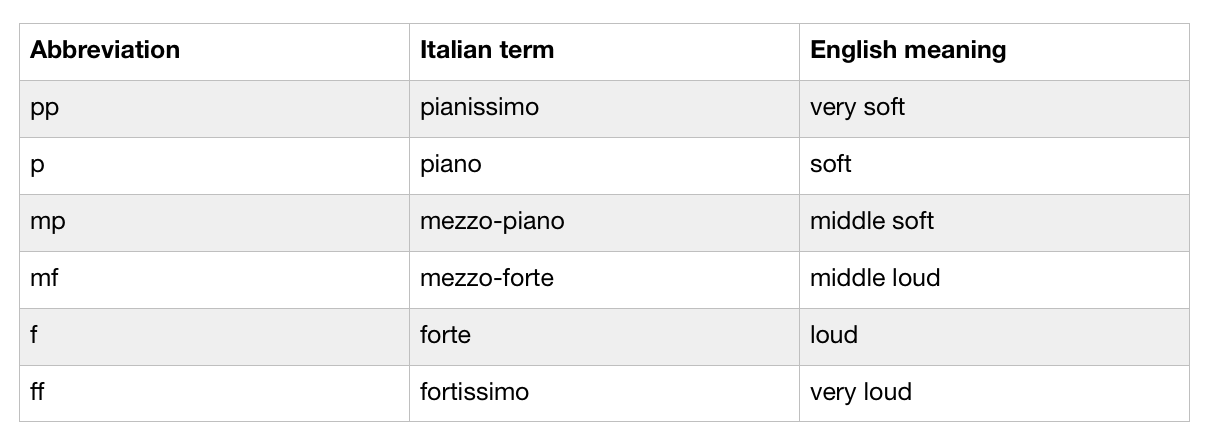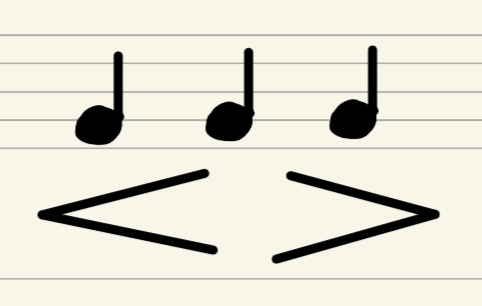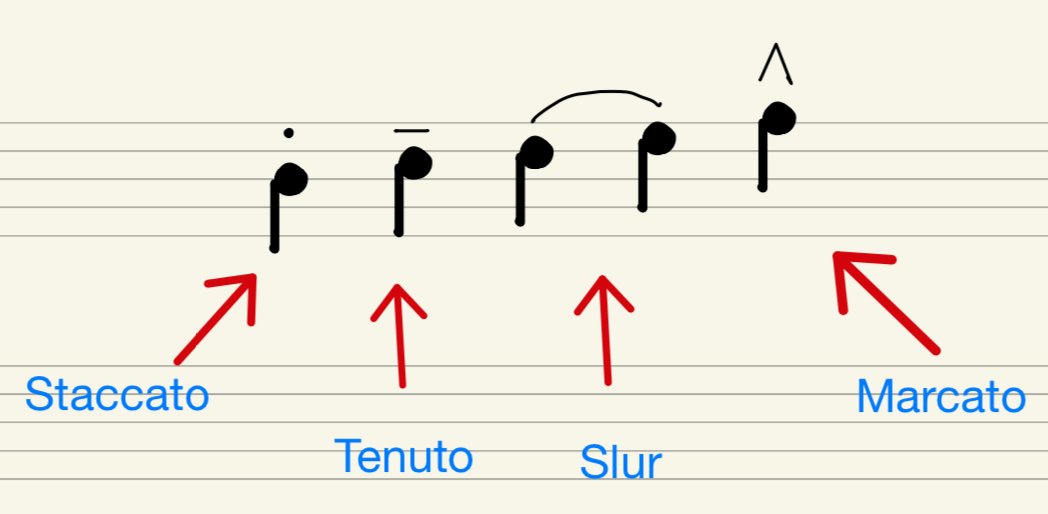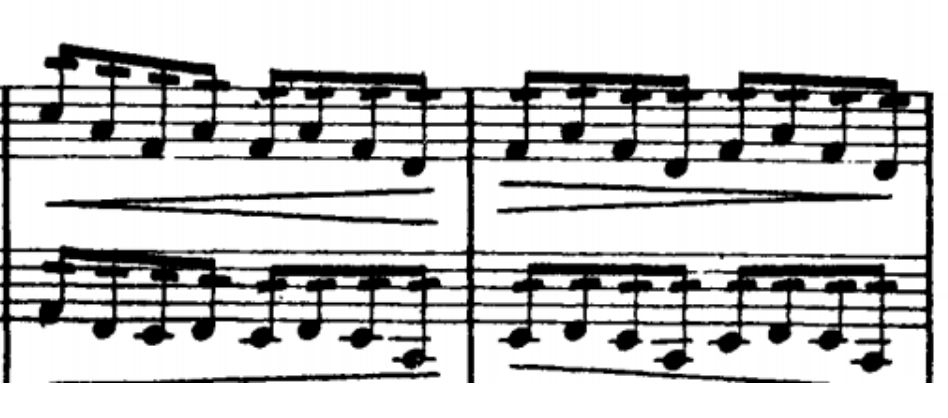Mickey Hansen
AP Music Theory 🎶
72 resourcesSee Units
Continuing with expressive elements, other ways to perform music are indicated by dynamic markings and articulation. We use dynamics and articulation to make music sound musical -- it adds interest, and it allows us to be expressive in our music. When you are playing music, dynamics and articulation are sometimes implied. The composer might not tell you to be loud or soft or connected or short, but based on context clues, you're able to figure this out.
This is especially true in older classical pieces, like Bach, Handel, and Mozart. Before music scores started being printed and published, it was assumed that the pieces would mostly be played by the composers themselves, so there was really no need to add dynamic and articulation markings. However, after the emergence of large music publishing agencies, composers started being more intentional about adding these markings.
Dynamics
Dynamic markings show how loud or soft the music ought to be played. Still using Italian 🇮🇹 terms, here is the list of dynamics with their accompanying abbreviations, from softest to loudest:

It is important to understand that dynamics are all relative. A forte in the first movement of Moonlight Sonata is a big deal! It is really loud! A forte in the third movement is Moonlight Sonata isn't so loud. Also, among different composers, forte and piano mean different things. You should use other context clues to determine the actual decibel level of loudness that you should play a piece.
Changes in dynamics can be shown with the following symbols:

Sometimes, when they are back to back, they are also called hairpins. The < symbol on the left is a crescendo, which means to increase the volume over the space indicated, and the > symbol on the right is the decrescendo, which means to decrease the volume. Sometimes, decrescendos are called diminuendos, and abbreviated "dim." on a score.

When an immediate change in volume is desired, a composer might write subito, which means suddenly. Sometimes, you won't see the word "subito," but you will see the dynamic change quickly from forte to piano or from piano to forte without a crescendo or a diminuendo. This would also be considered subito (you might say subito piano for suddenly soft, and subito forte for suddenly loud).
An isolated dynamic accent can be written with sf or sfz, which stands for sforzando. Sforzando is a dynamic marking that indicates a sudden, strong accent. It is usually written above the staff, and it indicates that the music should be played with a lot of emphasis or force. The term "sforzando" comes from the Italian word "sforzare," which means "to force" or "to strain."
A sforzando accent is often used to add drama or emphasis to a particular note or chord. It can be used to create a sudden, unexpected change in volume or to bring attention to a particular part of the music. When a sforzando accent is written into the music, the performer should try to create a strong, forceful sound, often by playing the note louder than the surrounding notes and using a more forceful technique.
Sforzando accents can be indicated in a variety of ways, including with the abbreviation sfz, a > symbol above the note, or a + symbol above the note. Sforzandos usually should not be ignored, even if the performer doesn't like them. Sforzandos can also tell you
Note: you may also find the occasion fff or pppp in some music. Can you sing "pianississississimo"?
Articulation
Composers may also want their music to be played with certain articulation. Articulation refers to the way that individual notes are played or sung in a piece of music. It can affect the phrasing, tempo, and overall character of the music, and it is an important aspect of musical expression. Sometimes articulation is also called an attack. Here are some common articulation names and their definitions:
Staccato articulation is indicated by a dot above or below the notes. It means that the notes should be played or sung shorter and separated, with a clear gap of silence between each note. However, this does not necessarily mean short notes. Sometimes, staccato notes are intended to be longer, but they will still have a pronounced gap between them.
Tenuto articulation is indicated by a straight line above or below the notes. It means that the notes should be played or sung with their full duration and with a slight emphasis. Sometimes, there will also be a small gap between tenuto notes, depending on the piece.
Legato articulation is indicated by a slur (a curved line) above or below the notes. It means that the notes should be played or sung smoothly and connected, without any separation between them. On a wind instrument, this means that you will not tongue the notes under the slur. For a string instrument, this means that you use the same direction of one bowing, and for piano/harp/percussion, it means to have a very connected line.
Sometimes, there will be a big slur-looking thing in musical pieces to indicate phrasing. This is not actually a slur, and it doesn't necessarily mean to play the notes connected. Instead, it tells you that this big section is one phrase, and it should be articulated like one musical sentence. We will learn more about phrasing in future chapters.
The reason why we use the same markings for phrasing and legato is that phrases sound sound like connected musical ideas, even if every single note isn't connected. You can tell whether something is a legato marking or a phrase depending on the piece and context. If there is a staccato inside of the line, then it probably isn't a slur. Also, if it is a big section, and these big "slurs" are happening at regular intervals, you can assume that these aren't real legato markings. Instead, they are phrases.
You also shouldn't confuse slurs with ties, which tell you to hold the same note. If two or more of all the same note are connected by a slur, then we might assume that this is a tie.
Marcato indicates that the notes should be played or sung with strong emphasis and a clear, detached sound. It is usually indicated in music notation by a small, triangular arrowhead above or below the notes, or by the abbreviation "mar." It might also be written like a staccato note in the shape of a triangle. Sometimes, there will be accents above the notes (which look like mini crescendos above the notes). This is also an indication to play the notes marcato, but we usually just call the markings accents.
Marcato articulation is often used to give a sense of emphasis or punctuation to the music. It is used to help bring out certain notes or phrases and to give them a more prominent and distinct character. When a marcato articulation is indicated in the music, the performer should try to create a strong, clear, and slightly accented sound, often by playing the notes louder and with a more forceful technique.

This is what the above sounds like back-to-back:
While this music was performed on an oboe, a piano or string instrument might have a slightly different nuances to how each of these articulations are physically played.
Lastly, here is what a tremolo looks like. Tremolo is also called vibrato (especially for string instruments) and it is an effect produced by rapidly repeating a single note or chord. It is often indicated in music notation with a set of wavy lines above or below the notes, and it is usually played on stringed instruments, such as the violin or guitar. The speed and depth of the tremolo effect can vary depending on the desired effect and the performer's technique.
Tremolo can add expression and intensity to a piece of music and can be used to create a sense of excitement or tension. It is often used in fast, virtuosic passages to add energy and momentum to the music. In slower, more lyrical passages, it can be used to add warmth and emotion to the sound.
Tremolo is produced on stringed instruments by rapidly moving the finger that is pressing down on the string back and forth, creating a vibrating effect. On other instruments, such as the flute or voice, tremolo can be produced by rapidly repeating a single note or by quickly alternating between two nearby notes.
Tremolo is an important aspect of musical expression and can be used to add character and interest to a piece of music. It is important for the performer to carefully follow the notation and any indicated tempo markings in order to achieve the desired effect.

🦜Polly wants a progress tracker: Can you practice singing the example that you heard played by the oboe? 🎤 Or play it on an instrument? 🎺 Read along with the recording of the oboe and then practice alone by yourself so you can get the understanding of the symbols into your ear.

Browse Study Guides By Unit
🎵Unit 1 – Music Fundamentals I (Pitch, Major Scales and Key Signatures, Rhythm, Meter, and Expressive Elements)
🎶Unit 2 – Music Fundamentals II (Minor Scales and Key Signatures, Melody, Timbre, and Texture)
🎻Unit 3 – Music Fundamentals III (Triads and Seventh Chords)
🎹Unit 4 – Harmony and Voice Leading I (Chord Function, Cadence, and Phrase)
🎸Unit 5: Harmony and Voice Leading II: Chord Progressions and Predominant Function
🎺Unit 6 – Harmony and Voice Leading III (Embellishments, Motives, and Melodic Devices)
🎤Unit 7 – Harmony and Voice Leading IV (Secondary Function)
🎷Unit 8 – Modes & Form
🧐Exam Skills
📚Study Tools

Fiveable
Resources
© 2025 Fiveable Inc. All rights reserved.